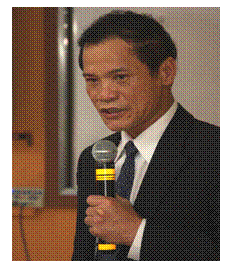HVWSHE Terminal Report
Workshop on Developing a Toolkit to Promote HVWSHE
in Southeast Asian Schools
SEAMEO INNOTECH, Diliman, Quezon City
30 July- 01 August 2008
TERMINAL REPORT
Table of Contents
Executive Summary |
3 |
Background |
8 |
Workshop Objectives |
11 |
Workshop Methodologies, Resource Persons and Facilitators |
11 |
Participants’ Profile |
14 |
Session Documentation |
15 |
Program Overview |
15 |
Presentation 1: Project Milestones |
16 |
Presentation 2: Project Experiences in Development the Resource Package |
16 |
Presentation 3: Toolkit Content and Case Study Guidelines |
17 |
Elevating Peak Experiences: Country Presentation |
18 |
Workshop on Consolidating Our Collective Project Experiences |
20 |
Presentation 4: HVWSHE Project Sustainability and Advocacy |
24 |
Writeshop to Enhance Selected Case Studies |
25 |
End-of-Course Evaluation by the Participants |
26 |
Social Support Services Provided to the Participants |
26 |
Annex: Copies of the Country Case Studies |
|
Executive Summary
“Water supply does not run dry if drawn from the well of human values.”
Water and sanitation crisis in Asia Water and sanitation have emerged as a critical concern in Asia due to the increasing urbanization in the region. This puts greater health risks especially among the urban poor due to lack of safe water, sanitation and hygiene. The water and sanitation crisis in Asia, which is home to nearly half a billion people and one of the most economically dynamic region in the world, is a crisis of good governance and cannot be eradicated by technical and regulatory measures alone. To tackle this crisis, the United Nations Human Settlements Program (UN HABITAT), Asian Development Bank and the countries in the region are pursuing the Water for Asian Cities Programme to fulfill the water and sanitation-related Millennium Development Goals and targets in Asian cities. Among the Programme’s thematic priorities is developing new ethic among children and communities by integrating human values in water, sanitation and hygiene education (HVWSHE).
Values based water, sanitation and health education The underlying principles of the HVWSHE project, which was originally implemented by UN HABITAT in African countries, resonated with a number of critical and urgent concerns in Southeast Asia: The project is directed towards sustainable human development bydeveloping the water and sanitation ethic of children who will be future decisionmakers and leaders in the region through quality and accessible education. These features are in line with the ASEAN Vision 2020 which aspires for a Southeast Asian region which is “outward looking, living in peace, stable and prosperous, bonded together in partnership in dynamic development and in a community of caring societies”.
The SEAMEO-UN HABITAT HVWSHE Project The SEAMEO-UN HABITAT Cooperation became a full-blown project to promote HVWSHE in Southeast Asian schools by the signing of the cooperative agreement in November 2005. The project sought to address both infrastructure concerns and curricular interventions relating to water, sanitation and hygiene. The project implementation took two major tracks: the development of an assessment protocol on water and sanitation facilities in schools and building capacity in the Ministries of Education and pilot schools to effectively integrate HVWSHE in lessons. Linking human values with water, sanitation and hygiene issues goes beyond imparting and acquiring knowledge and information and focuses instead to inculcating positive attitudes and values, as well as the desired behaviors. Specifically, the project intended to accomplish the following objectives:
- Developing the competencies of teachers in selected schools in integrating HVWSHE in their lessons, effective use of resource materials; and in assessing knowledge, skills, attitudes and behavior change among students;
- Developing prototype teaching/learning materials, lesson plans, activity guides and, among others, on HVWSHE appropriate in SEA context;
- Documenting experiences, lessons learned and effective practices in introducing HVWSHE in schools;
- Developing a common WatSan facilities and HVWSHE assessment protocol among the Ministries of Education; and
- Developing a resource package/toolkit on HVWSHE for project officers of the Asian Development Bank.
Participation of SEAMEO Centre The project entailed the cooperation of SEAMEO Units to spearhead various components of the project: the SEAMEO Secretariat provided the overall project coordination function, SEAMEO TROPMED Network (SEAMEO Tropical Medicine and Public Health) developed the school water and sanitation assessment protocol, SEAMEO INNOTECH (Regional Centre for Educational Innovation and Technology) took charged of the regional workshops on developing teaching and learning materials and project monitoring and evaluation, SEAMEO SEAMOLEC (Regional Open Learning Centre) reviewed the initial draft of the lesson plans and developed the SEAMEO Resource Package while SEAMEO RECSAM (Regional Centre for Education in Science and Mathematics) organized the training of trainers on integration of HVWSHE in their lessons. The integration of HVWSHE into the learning program at the country levels were coordinated through the various Ministries of Education who then selected schools to pilot the project at the local level.
Final Project Output As a final activity under the project, the Workshop on Developing a Toolkit to Promote HVWHSE in Southeast Asian Schools was organized by the SEAMEO Regional Center for Educational Innovation and Technology in Quezon City, the Philippines on 30 July to 01 August 2008. The workshop sought to bring together the education workers from the SEAMEO member countries that have actively participated in implementing the project in their respective countries to discuss their significant experiences, learning and innovations in the process of implementing the project and in integrating HVWSHE in their lessons. Their insights would be the core component of the Toolkit to Promote HVWSHE in Southeast Asian Schools, which is the principal and final output of the project.
The proposed HVWSHE Toolkit is intended to be a relevant and up-to-date reference guide on HVWSHE for use mainly of project officers of development-oriented agencies as well as teachers, administrators and development workers, and decision-makers in the elementary and secondary education sector. Packaged in CD format, the Toolkit will chronicle the project milestones, selected case studies, and the assessment protocol. It will also include a section on advocacy and communications materials to promote the project.
The Workshop on Developing a Toolkit to Promote HVWHSE in Southeast Asian Schools was participated in by 11 project implementers from eight SEAMEO member countries - Brunei, Cambodia, Indonesia, Lao PDR, Malaysia, Philippines (2), Thailand and Vietnam as well as representatives from SEAMEO Secretariat and SEAMEO SEMOLEC. The sessions were designed to ensure maximum participation and engagement of the participants as they share of stories and experiences about Project HVWSHE, what they value most about the Project, and their wishes for the Project to make more of these positive experiences possible; discuss the success factors, major lessons, and innovations and consolidate of recommendations to improve and sustain the gains of the Project.
Overall Achievements The sharing of experiences of the participants in the Workshop highlighted an overall increase in awareness and appreciation of school communities on wise and sustainable use of water, sanitation and hygiene facilities. There was an apparent improvement of competencies of selected SEA school on integrating HVWSHE in some core learning areas and school affairs and in using the resource materials. Also, selected schools who used the SEAMEO Resource Package, which contained four lessons plans per country and one lesson plan per subject, modified and improved these prototypes to fit their country context. Others even went to the extent of developing relevant learning and teaching materials. To some extent, some of these schools documented their experiences, lessons learned and effective HVWSHE practices in selected schools and shared these with other schools in nearby areas. Some schools were able to assess attitudinal and behavior changes among students although there is still a need for an improved assessment instrument.
Selected Experiences on Project Implementation On a per country basis, the sharing of experiences of participants from Brunei, Malaysia and the Philippines showed that they were able implement the project at the school level by engaging selected primary and secondary schools that formed the SEAMEO Regional Coalition on Quality and Equity in Education (QEE schools). These schools were able to integrate HVWSHE in selected core learning materials and in school affairs.
The participant from Thailand’s MOE reported that they integrated components of HVWSHE (along with global education, child-friendly schools) as part of the whole school approach in their current One District, One Lab School Project. This project by the Ministry of Education in Thailand seeks to provide access to quality education at the community level for all Thai children to fully develop their individual potentials.
The participant from Lao PDR’s MOE highlighted their initiative in incorporating the HVWSHE in the curriculum, teachers’ guide and textbooks in all education level (kindergarten, primary and secondary) that they will roll out starting September 2008. She also reported on the thrust of Lao PDR to provide and create conditions for holistic development of school-aged children through its “National School Health Policy”. Under this initiative, the government cooperated with JICA and UNESCO in improving the available tools for school health education, which also included underlying principles of the HVWSHE.
Part of reflecting on the experiences of the participants in promoting and integrating HVWSHE in their respective schools was to look back at the challenges and problems encountered while implementing the project. From these challenges, meaningful lessons were learned which can serve as inputs in further enriching the project.
The participants were also asked to provide inputs and recommendations on how to sustain the gains of the project and in the design and or possible extension of HVWSHE project in the immediate future. They have outlined specific recommendations on the following areas:
- Project design
The participants recommended the possibility of integrating HVWSHE with other existing projects in the schools and the expansion of the project in other levels. The inclusion of monitoring and evaluation at project conceptualization stage and the use of authentic behavioral assessments were also recommended.
- Curriculum
While the extent of curriculum implementation varies from country to country, it was recommended that flexibility and creativity be allowed to facilitate integration of HVWSHE in the existing curriculum. Possibility of translating the HVWSHE resource materials and lesson plans was also suggested.
- Teaching and Learning Practices
This involves strengthening the capacity of the schools to becoming a knowledge center for learning communities which include continuous training of the teachers, school heads and supervisors on integrating HVWSHE, learning from the local and indigenous knowledge and local wisdom from the community
- Building Partnerships
To ensure project sustainability, linkages and partnerships with parents, community associations, local government and NGOs, local universities need to be built/and or expanded. There is a need as well to organize a coordinating body that will oversee program planning, implementation, monitoring and evaluation of HVWSHE project.
- Advocacy and Social Mobilization
There is a strong need to develop champions and advocates of HVWSHE project at all levels and strengthen social mobilization activities.
- Sustainability
Develop a strategy of ensuring enhanced ownership of the project by its stakeholders and finding a way by which the core values on water, sanitation and hygiene among the students can be further strengthened
- Policy Improvement
It was highly recommended that the concerned Ministry of Education (MOE) formulate implementing guidelines on how best to integrate HVWSHE in the Master Education Plan and current curriculum.
The 3-year pilot run of the HVWSHE Project highlighted the importance of a collaborative effort among SEAMEO Units, UN HABITAT, Asian Development Bank and other development agencies, ministries of education and selected schools of SEAMEO member countries towards the realization of a shared vision “to promote through value based water education, a new use and sanitation friendly ethic and hopefully the provision of water and sanitation to all schools and communities”. Despite limited resources, the experience underscored the importance of superior strategies to hurdle the challenges towards good governance and sustainable development in Southeast Asia through values-based education.Background
The Cooperation between UN-HABITAT and SEAMEO on Integrating Human Values in Water, Sanitation and Hygiene Education in Southeast Asian countries which started in December 2003 led to the formulation and implementation of strategic programmes to operationalize the Ministerial Declaration on Values-Based Water Education including sanitation and hygiene.
Water and sanitation have emerged as a critical concern in Asia due to the increasing urbanization in the region which puts greater health risks especially among the urban poor due to lack of safe water, sanitation and hygiene. To tackle this crisis, the United Nations Human Settlements Program (UN HABITAT), Asian Development Bank and the countries in the region are pursuing the Water for Asian Cities Programme to fulfill the water and sanitation-related Millennium Development Goals and targets in Asian cities. Among the Programme’s thematic priorities is developing new ethic among children and communities by integrating human values in water, sanitation and hygiene education (HVWSHE).

The underlying principles of the HVWSHE project, which was originally implemented by UN HABITAT in African countries, resonated with a number of critical and urgent concerns in Southeast Asia: The project is directed towards sustainable human development byinculcating water and sanitation ethic in children who will be future decision makers and leaders in the region through quality and accessible education. These features are in line with the ASEAN Vision 2020, which aspires for a region which is “outward looking, living in peace, stable and prosperous, bonded together in partnership in dynamic development and in a community of caring societies”.
The promotion of Values-based Water and Sanitation Education among the Southeast Asian Schools (as illustrated in Figure 1) entailed the collaboration of stakeholders – development agencies (UN HABITAT, Asian Development Bank, UNESCO, JICA, etc.), government agencies (Ministries of Education, Water and Sanitation, Health, etc), water and sanitation service and schools – to promote investments for safe water and sanitation in school and learning centers which can lead to community-wide action. The project was implemented in two tracks involving the: 1) Development of an Assessment Protocol on Water and Sanitation Facilities in Schools and 2) Integrating Human Values in Water, Sanitation and Hygiene Education in Southeast Asian Schools.
In November 2005, a regional planning workshop was convened to collectively review country experiences relating to water and sanitation in schools. The major output of this workshop was a draft assessment protocol, which facilitated developing a profile of the status of water and sanitation facilities in the schools in the region. Other critical areas that were discussed and agreed upon in the workshop were: 1) competency requirements for teachers for integrating human values in lessons; 2) teaching and learning materials that would facilitate integration of human values in water, sanitation and hygiene education; and 3) identification of the core learning areas in science, mathematics and combination of social studies/values/arts where human values would be integrated.
Taking off from these achievements, another regional workshop was conducted in October 2006 to develop sample integrated HVWSHE lesson plans as well as activity guides, games, exercises, songs which could be integrated in the selected core learning areas for use in the classrooms. The workshop was also able to provide an overview of the assessment methods, which could be adopted in teaching human values. The participants were asked to review and revise, if necessary, the lesson plans and activity guides, pilot-test these learning materials, and make an initial assessment of some observable changes in students’ reactions and attitudes on water, hygiene and sanitation. This involved taking a look at how the teachers were able to facilitate and manage the integrated HVWSHE lessons and learning activities.
The HVWSHE lesson plans aimed to integrate the five core human values -- truth, right conduct, love, peace and non-violence -- in water education adapted from the Johannesburg consultation in South Africa on April 30 to May 2001. Examples and practical applications of these core values are connected to key issues in water, sanitation and hygiene education in Southeast Asian schools. This approach is meant to create a new water use and sanitation ethic that promotes positive behaviors among the learners to minimize current water wastage in human settlements.
The recent regional workshop on Monitoring and Evaluation of the Project was held in Manila on 28-30 April 2008 to assess experiences in adopting the integrated HVWSHE in their respective countries, identify some areas for improvement in the existing teaching-learning materials and other innovations adopted, agree on the monitoring and evaluation framework for the Project, develop assessment tools to determine the effectiveness of the integrated HVWSHE teaching-learning materials, and formulate guidelines for the assessment of integrated HVWSHE teaching-learning materials for use by teachers and principals.
As a final activity under the project, the Workshop on Developing a Toolkit to Promote HVWHSE in Southeast Asian Schools was organized by SEAMEO INNOTECH, the SEAMEO Regional Center for Educational Innovation and Technology in Quezon City, the Philippines on 30 July to 01 August 2008. The workshop sought to bring together the education workers from the SEAMEO member countries that have actively participated in implementing the project in their countries to discuss their significant experiences, learning and innovations in the process of implementing the project and in integrating HVWSHE in their lessons. Their insights would become the core component of the Toolkit to Promote HVWSHE in Southeast Asian Schools, the principal and final output of the project.
Workshop Objectives
The Workshop aimed to highlight the HVWSHE Project outcomes and opportunities, innovations, and learning/insights gained in implementing the HVWSHE project in the SEAMEO countries, and generate inputs for the development of the HVWSHE Toolkit.
By the end of the workshop, the country participants would be able to:
- Share their country specific stories of innovations, achievements, challenges and lessons gained in the process of introducing, integrating and promoting the human values in water, sanitation and hygiene education in South East Asian schools;
- Identify areas for improving effectiveness of HVWSHE including recommendations to strengthen likelihood of sustaining benefits from the Project; and
- Develop inputs for the toolkit in promoting HVWSHE for use by project developers, evaluators and educators.
Workshop Methodologies, Resource Persons and Facilitators

The Workshop was designed to ensure maximum participation and engagement of the participants all throughout the sessions. The Workshop comprised of a series of country presentations and important discussions on the development of the HVWSHE toolkit, followed by small group discussions or mini-workshops to flesh out the overall insights, learning and future actions that need to be undertaken to ensure project sustainability, heighten advocacy on human values-based water, sanitation and hygiene education, and advance the gains of the project.
To put the discussions into context, inputs on project milestones, development of the SEAMEO HVWSHE Resource Package, and the project advocacy were provided.
To produce the expected outputs, small groups were organized for the:
- Sharing of best stories and experiences about Project HVWSHE, what they value most about the Project, and their wishes for the Project to make more of these positive experiences possible;
- Discussion of the success factors, major lessons, and innovations which the participants/stakeholders can be proud to say is a direct outcome of Project HVWSHE;
- Consolidation of recommendations to improve and sustain the gains of the Project; and
- Finalization of the contents of the toolkit using the results of the workshop.
The matrix of the detailed schedule of activities and resource persons is shown in the following section. The workshops were facilitated by a SEAMEO INNOTECH team composed of Ms. Edith Pimentel, Head, Training Unit; Ms. Yolly De Las Alas, Head, Long-term Capability Building Unit, Mr. Odelon Gines, Project Officer and Ana Liza Serrana, Training Associate Specialist. Documentation of the workshop proceedings was provided by the INNOTECH’s ICT Services.
Date/Time |
Topic/Activity |
30 July 2008, Wednesday |
|
8:00-8:30 |
Registration |
8:30-9:00 |
|
9:00-10:00 |
|
10:00-10:15 |
Morning Tea/ Coffee Break |
10:15-10:45 |
|
10:45-11:00 |
|
11:00-12:00 |
|
12:00-1:30 |
Lunch Break |
Date/Time |
Topic/Activity |
1:30-3:30 |
|
3:30-3:45 |
Afternoon Tea/ Coffee Break |
3:45-5:00 |
|
|
|
31 July 2008, Thursday |
|
8:30-10:00 |
Plenary Presentation |
10:00-10:15 |
Morning Tea/ Coffee Break |
10:15-12:00 |
Plenary Presentation |
12:00-1:30 |
Lunch Break |
1:30-4:30 |
Plenary Presentation |
|
Individual Writeshop: Enhancement of the Country Case Study |
1 August 2008, Friday |
|
8:30-12:00 |
Individual Writeshop: Generating Additional Inputs to the Toolkit |
12:00-1:30 |
Lunch Break (Juma’ah Prayers for Muslim Participants) |
1:30-3:00 |
Open Discussion |
3:00-3:30 |
|
2 August 2008, Saturday |
|
|
|
Participants’ Profile
Eleven (11) project implementers from eight (8) member countries of SEAMEO -- Malaysia, Brunei Darussalam, Cambodia, Indonesia, Lao PDR, the Philippines (2), Thailand and Vietnam, and two from SEAMEO Secretariat attended the training course. A summary of the participants profile is shown in the matrix below (See Participants’ Directory in Annex 1).
Profile of Participants |
||
|
Number |
% |
Gender |
||
Male |
5 |
45 |
Female |
6 |
55 |
Age |
||
Below 35 years |
1 |
10 |
36-40 years |
3 |
27 |
41 years and above |
7 |
63 |
Position |
||
Teacher |
3 |
27 |
Ministry of Education Officer (Education Officer, Deputy Director, Director, Researcher |
5 |
46 |
SEAMEO Unit (SEAMEO Secretariat, SEAMEO SEAMOLEC) |
3 |
27 |
Length of Service in Unit |
||
Less than 5 years |
5 |
45 |
5-15 years |
4 |
36 |
Over 15 years |
2 |
18 |
Highest Educational Attainment |
||
Bachelors Degree |
1 |
11 |
Masters Degree |
6 |
67 |
Doctoral Degree |
2 |
22 |
Session Documentation
Program Overview
The three-day workshop was formally opened with a brief program, which was attended by the officials of SEAMEO INNOTECH. Mr. Benito E. Benoza, Head of Corporate Planning and Partnerships Office, warmly welcomed the participants from the eight countries including the two officials from SEAMEO Secretariat and SEMOLEC. Mr. Benoza stressed the importance of the HVWSHE Project for the sustainable development of the region and the role of education in inculcating a new water and sanitation ethics to children who will be the future decision makers and leaders.
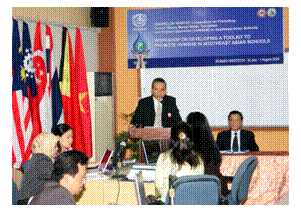
Dr. Wahdi SA Yudhi, Deputy Director of the Programme and Development Unit of SEAMEO Secretariat, also welcomed the participants to the Workshop to collaborate for the development of the HVWSHE Toolkit, which is the final output of this phase of the Project. He then informed everyone of the plans to expanding the project in other schools and to develop modules to bring the program to the community-level.
Ms. Editha Pimentel, Head of INNOTECH’s Training Unit provided the overview of the three-day workshop She walked them through the flow of the day-to-day sessions and the administrative concerns. The spirit of camaraderie pervaded in the classroom as almost all participants know each other while working in the HVWSHE project for the past years.Presentation 1: Project Milestones
To put the succeeding discussions into context, Mr. Duc Dac Nguyen, Programme Officer of SEAMES Programme and Development Unit, walked the participants through the entire project experience. He summarized the project milestones that were accomplished since the inception, the recent developments, and activities to be done before the final project completion. As the springboard for assessing the accomplishments in the project, he highlighted the following project objectives:
- Developing competencies of teachers in selected schools in integrating HVWSHE in their lessons, effective use of resource materials; and in assessing knowledge, skills, attitudes and behavior change among studentsDeveloping a set of prototype teaching/learning materials, lesson plans, activity guides and, among others, on HVWSHE for use in SEA schools
- Documenting experiences, lessons learnt and effective practices in introducing HVWSHE in Southeast Asian schools
- Developing a common WatSan facilities and HVWSHE assessment protocol among the Southeast Asian Ministries of Education
- Developing a toolkit on HVWSHE
Presentation 2: Project Experiences in Developing the Resource Package
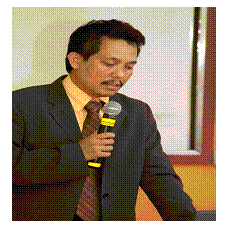
Dr. Jaslin Ikhsan, Ad Interim Deputy Director of SEAMEO SEAMOLEC, discussed the framework and processes used in developing the lessons plans resource package for integratedHVWSHE lessons. The following are the thematic strands used in the lesson plans: 1) water, environmentally sustainable development, 2). water, social equity and human dignity, 3) water for health, sanitation and recreation, and 4) water in culture, traditions and religious practices. Using the instructional sequence as shown in Figure 2, prototypes of lessons plans were developed and put together into a Resource Package. Integrating HVWSHE in school subjects under the four thematic strands entails a series of Classroom Action Research (CAR) activities of planning, acting, observing and reflecting.
Presentation of Toolkit Content and Case Study Guidelines
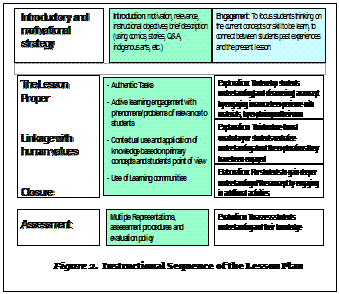
SEAMEO INNOTECH’s Program officer Mr. Odelon Gines explained the content of the HVWSHE Toolkit. He also discussed the Case Study Guidelines to enable the participants to have a common understanding and appreciation of the tasks ahead of them.
The proposed toolkit is intended to be a relevant and up-to-date reference guide on HVWSHE for project officers of development-oriented agencies, teachers, administrators and development workers, and decision-makers in the elementary and secondary education sector. Packaged in CD format, it will chronicle the project milestones, selected case studies, and the assessment protocol. It will also include a section on advocacy and communications materials to promote the project.

The case study guideline would serve as the framework for documenting selected experiences in implementing the HVWSHE Project in South East Asian Schools. The case study would document the situation of the school (or of the bureau at the MOE), the project implementation steps and strategies taken to implement the HVWSHE program, strengths of the program (policies that facilitated implementation, leadership of the school head, commitment of teachers) the challenges met at each step (policies that hindered implementation, lack of resources) and actions taken to overcome them. Also to be included are the advocacy and social mobilization activities undertaken with the community, local government, media, and private sector and the assessment of the project results (impact of the program on students’ knowledge and values as shown in their attitudes and behaviors, like reporting leaking faucets, joining school activities to promote water conservation, etc).
Since changes in human values are the focus of HVWSHE, it is important to report whether the program led to observed positive changes in the values of students. Responses to the following questions would be presented as well in the toolkit:
- What do students and project stakeholders consider as their most important gain from the program?
- Who and what factors made the program successful?
- What were the major lessons learned?
The study would also cover recommendations to improve implementation and sustain gains, what needs to be done in the school in the area of policy, program design, teacher training, curriculum, and partnerships.
Elevating Peak Experiences: Country Presentations
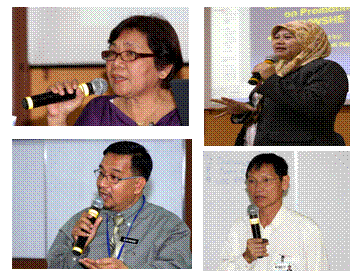
In this session, all participants shared their stories on HVWSHE project introduction and rollout at school and ministry/bureau level. Overall, the sharing of stories from different countries on project implementation highlighted an overall increase in awareness and appreciation of school communities on wise and sustainable use of water, sanitation and hygiene facilities. There was an apparent improvement of competencies of selected SEA school on integrating HVWSHE in some core learning areas and school affairs and in using the resource materials.
Also, selected schools who used the SEAMEO Resource Package, which contained four lessons plans per country and one lesson plan per subject, modified and improved these prototypes to fit their country context. Others even went to the extent of developing relevant learning and teaching materials. To some extent, some of these schools documented their experiences, lessons learned and effective HVWSHE practices in selected schools and shared these with other schools in nearby areas. Some schools were able to assess attitudinal and behavior changes among students although there is still a need for an improved assessment instrument.
On a per country basis, the sharing of experiences of participants from Brunei, Malaysia and the Philippines showed that they were able implement the project at the school level by engaging selected primary and secondary schools that formed the SEAMEO Regional Coalition on Quality and Equity in Education (QEE schools). These schools were able to integrate HVWSHE in selected core learning materials and in school affairs.
The participant from Thailand’s MOE reported that they integrated components of HVWSHE (along with global education, child-friendly schools) as part of the whole school approach in their MOE’s One District, One Lab School Project . The project seeks to provide access to quality education at the community level for all Thai children to fully develop their individual potentials. The project puts emphasis on character development, search of knowledge, reading habits, independent learning, good conduct, morality, critical thinking, modern life skills and appreciation of the Thai culture.
The participant from Lao PDR’s MOE highlighted their initiative in incorporating the HVWSHE in the curriculum, teachers’ guide and textbooks at all education level (starting from kindergarten, primary up to secondary school level). She reported that they are ready to roll out this new curriculum in September 2008 for pilot testing. She also reported on Lao’s thrust to provide and create conditions for holistic development of school-aged children through its “National School Health Policy” . Under this initiative, the government cooperated with JICA and UNESCO in improving the available tools for school health education, which also covered the underlying principles of the HVWSHE Project.
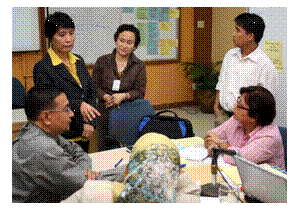
Workshops on Consolidating Our Collective Project Experiences
Prior to the start of the workshops on Day 2, SEAMEO INNOTECH Training Associate Specialist Ms. Ana Liza Serrana, briefly walked the participants on the highlights of the previous day’s activities. She emphasized that the current water and sanitation crisis in Asia is basically a crisis of good governance, which resulted to Asia (vis-à-vis the rest of the world) having the largest proportion of peoples without access to safe sanitation and clean water. While infrastructure and technology alone could not solve this problem, integrating values-based to sanitation and water education could hopefully bring in the attitudinal and behavioral changes for new water wise and sanitation friendly ethics.
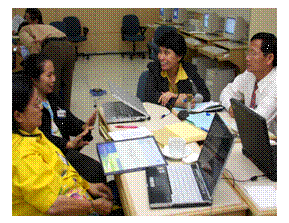
The first workshop focused on revisiting the challenges encountered in the project rollout and how these were addressed. Based on their collective experiences, the participants were asked to identity success factors and challenges faced in the course of the project implementation. The participants were grouped in terms of level of implementation. Those from Brunei Darussalam, Malaysia and the Philippines were grouped together as they were able to implement the project at the school level. Participants from Cambodia, Lao PDR, Thailand and Vietnam sat together and discussed their experiences as they From the Ministry level. Representatives from SEAMES and SEAMEO SEMOLEC recounted their observations in terms of the overall project implementation.
After a specified time, each group presented the outputs of their discussions. Some of the success factors and challenges identified are:

Success Factors
- The resonance and alignment of HVWSHE principles to the overall goal of sustainable human development and environmental management.
- Supportive PTCA, local government units, NGOs, universities, other community members
- Strong leadership of school director and supervisors
- Mentoring and coaching of supervisors
- Commitment, creativity, flexibility, resourcefulness of school director, teachers, students
Challenges
- Need for common understanding and appreciation of the HVWSHE goal/objectives among stakeholders and implementors
- Smooth rollout of MOE of the HVWSHE Project to schools
- Lack of parents’ orientation and involvement
- Review the content, scope and depth of teaching and learning materials
- Limited integration of HVWSHE in the curriculum due to lack of focus/skills among teachers; lack of teachers; inadequate skills in classroom management
- Inadequate support of school heads, master teachers and supervisors
- Authentic assessment of attitudinal and behavioral changes among students
- Inadequate monitoring; limited documentation support
- Sustaining coordinating linkages
- Funding support
- Language posed a hindrance, as in the case of Indonesia, on the effective use of lesson plans that were in English.
- The limited capacity to document project implementation was a concern of some countries.
- There was a lack of criteria to be followed in determining which schools to involve in the project.
In the subsequent next workshop, Ms. Yolanda de las Alas, Head of SEAMEO INNOTECH’s Long-Term Capability Building Unity, anchored the collective recommendations to be culled from the participants on how to sustain the implementation of the project to the targets related to water and sanitation for the 2015 Millennium Development Goals which is to reduce into half the proportion of people without access to safe water (980 million in Asia) and adequate sanitation facilities (1.5 billion) in a region where deprivation of these service is most strongly felt). Ms. De las Alas requested the participants to categorize their recommendations into: policy implications, teaching and learning practices, program design, building partnerships, projectsustainability and advocacy, among others. After their discussion, the participants presented the following insights and suggestions:
Program Design
- Integrate HVWSHE with other projects (child-friendly school, health and nutrition program)
- Expand program implementation; include pre-school to secondary levels; cover non-QEE schools
- Include monitoring and evaluation plan from the start; formulate KPIs and communication plan
- Develop authentic behavioral assessment instruments
Curriculum
- Allow flexibility and creativity to suit actual needs of the school
- Review the basic education curriculum (apply in related subjects)
- Translation of resource materials into English, local, and/or national languages
Teaching and Learning Practices
- Strengthen capacity of schools as knowledge centers for learning communities;
- Train school leaders, head teachers and supervisor first
- Intensify and continue training of teachers on integrating, using and assessing the HVWSHE in SEA schools and in classroom management techniques, using contextual teaching and learning among others.
- Invite local wisdom as lecturers from the community, universities, non-government organizations
- Explore benchmarking opportunities for learning best practices thru study tours, websites, symposia, conferences, project-based and community-based learning, action research
Building Partnerships
- Expand linkages with parents and community associations, local government and non-government organizations, water utility companies and universities as service providers and/or sponsors
- Organize a national coordinating body to spearhead program planning, implementation, monitoring and evaluation of HVWSHE activities at the MOE-State Director level and at the school level with MOU/MOA)
Advocacy and Social Mobilization
- Develop HVWSHE advocates/champions among school community leaders/members
- Develop and intensify social mobilization activities
Sustainability
- Introduce HVWSHE from pre-school to secondary education
- Select volunteer schools with great need for water, sanitation and hygiene facilities
- Instill sense of ownership of the project among stakeholders
- Sustain students’ practice of the 5 core values on water, sanitation and hygiene
Policy Improvement
- MOE to formulate implementing guidelines on how to best integrate HVWSHE across curriculum
- Integrate HVWSHE in the MOE’s annual master plan
- School-community to formulate and enforce policies on proper management of water, sanitation and hygiene facilities and funding requirements
- Formulate guidelines in school selection (criteria, who selects, coverage)
On Day 3, Ms. Yolanda delas Alas started the morning’s session with a report on the collective recommendations of the participants based on the outputs gathered from yesterday’s activity. She emphasized that “the challenge is how to effectively and consciously integrate, apply and assess students’ behavioral change in terms of 5 core human values in water, sanitation and hygiene education.”
Presentation 3: HVWSHE Project Sustainability and Advocacy
In his presentation Mr. Benoza reiterated Project SEAWAVE’s (or Southeast Asian Water, Values and Education” a proposed new name for HVWSHE) rationale. He explained the two-track implementation of the project. The first track covered the development of the assessment protocol to build database of water and sanitation facilities as basis for measuring achievement of the Millennium Development Goal. The second phase, in which most of the participants were involved, focused on capacity building which he likened to throwing a pebble into a pool of water that creates ripples around it. From the HVWSHE project, it goes out to the schools then to the Ministries of Education and its field units, and finally, to the SEAMEO Council.
Mr. Benoza went on to explain that from the school level, resource materials were developed, teachers were trained, and extra and co-curricular activities were held. From the MOE level and its field units, policies, programs and plans were influenced, and funding support investments were sought. He also mentioned that progress reports were done at each SEAMEO meetings to monitor. He revealed that UNESCO conducted mid-term review while the SEAMEO took charge of advocating for the project to gain support from stakeholders. :
- Schools were in charge of instituting changes in lessons, classroom management, student learning and behavior using the resource Pack, training of teachers and extra and co-curricular activities.
- The Ministries of Education were to influence policy, plans, program funding support and investments. They were also in charge of disseminating information materials, progress reports/updates, maintaining the WatSan (water and sanitation) database and national activities
- , local development plans, investments for health and water services in schools and for the stewardship of these water resources jointly with other stakeholders.
- The SEAMEO Council was in charge of disseminating appreciation of HVWSHE policy, plans and programs and funding support at the regional level and attainment of goals in line with the MDGs.
Dr. Wahdi S.A. Yudhi, SEAMEO Secretariat Deputy Director for Program and Development elaborated that ASEAN has an important role in the success of HVWSHE. He reminded them that the output of the workshop would be of great help to the Ministries of Education, and to the teachers. He asked the participants to make the project implementation easy for the teachers. Their output, which is a toolkit, should be “simple and easy to be implemented and be understood by everyone.” Otherwise, he said, no matter how great the project is, it would not flourish.
Writeshop to Enhance Selected Case Studies
Mr. Jesse Tuason, INNOTECH Publication and Documentation Officer, explained the mechanics for the writeshop. The participants were asked to improve the case studies based on the results of the Workshop. For those who documented experiences at the school level, they were asked to provide concrete examples to abstract ideas mentioned. They were also asked to include a description of each school’s water and sanitation facilities before and during the project implementation. In addition, the participants were asked to prepare a write-up about the processes involved in the school implementation of HVWSHE in their respective countries.
Those participants who were yet to rollout the program from their MOE unit were also asked to document their experiences.
After several clarificatory questions were addressed, the participants started working individually on the review and refinement of their case studies. Deadline for submission of revised outputs is on August 8, 2008. (See Country Case Studies)
End of Course Evaluation by the Participants
The training management team ensures that the feedback and reactions from the participants are generated within the duration of the workshop to be able to immediately address areas that need attention and or modification, in the design, substance and in the overall management of the workshop.
Based on the results of the end-of-course evaluation, the participants gave an overall rating of 4.50 or extremely satisfied on the items measuring the following (See Annex 10: End of Program Evaluation Results):
- Set objectives were clear and achieved at the end of the workshop
- Topics were logically arranged
- Workshop content, presentations and activities provided were relevant to their work
- Adequate and useful workshop materials and handouts
- Workshop materials congruent with design
- Workshop methods used were appropriate
Social Support Services Provided for the Participants
Participants were met by SEAMEO INNOTECH staff upon arrival at the Ninoy Aquino International Airport and transported in an INNOTECH vehicle to the Center’s International House at SEAMEO INNOTECH located inside the University of the Philippines Diliman Campus. Similar arrangement was made for them in going back to the airport for their flight home at the end of the course.
Participants were received and briefed on INNOTECH’s facilities by the assigned IH officer. Each room is air-conditioned and has private toilet and shower, refrigerator, cable television, telephone and provision for Internet connection. Accident and travel insurance was also arranged for them.
They were provided with their allowances for their meals and other requirements. All their meals were provided by the program.
Each participant was issued a Workshop kit containing the Handbook (covering course objectives, the course content, methodologies to be employed, outputs expected and the tentative schedule of day-to-day activities), training bag and ring binder, notebook and other stationary supplies for the writing of notes and reflection and orientation materials (which included welcome letter and briefing notes on opening activities, guidelines on their accommodation, tips on using local transportation, list of commonly used Filipino words and phrases and a map of Metro Manila and the Philippines). At the end of the Workshop, they were provided with a Directory of Participants along with their Certificate of Completion during the Certificate Awarding Ceremonies plus a CD containing the course highlights and a DVD containing all the photos taken during the course and presentation materials of the resource persons.
On two afternoons, social outings were arranged for the participants. For Muslim participants, a trip to the mosque was arranged on Friday for them to attend the Juma’ah prayers.
As SEAMEO INNOTECH alumni, the participants are entitled to free use of the SEAMEO INNOTECH Learning Resource Center and ten per cent (10%) discount on room
